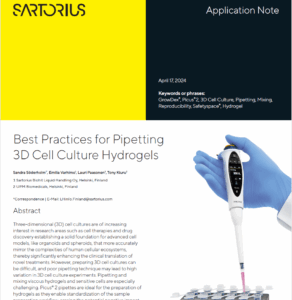Three-dimensional (3D) cell cultures, including organoids and spheroids, play a critical role in advancing drug discovery, disease modeling, and cell therapy development. Their ability to mimic the complexity of human tissue offers more predictive results and introduces new challenges in sample preparation.
Viscous hydrogels and sensitive cell suspensions are particularly difficult to handle, and inconsistent pipetting technique can lead to variability, reduced viability, and compromised data.
This application guide outlines strategies and tools to reduce variation and improve reproducibility in 3D cell culture workflows.

Key highlights include:
- How pipetting errors affect the reproducibility of spheroid and hydrogel-based assays.
- Why Picus® 2 electronic pipettes are ideal for viscous hydrogel handling, enabling consistent technique, and minimizing user-dependent variation.
- How GrowDex®, a ready-to-use, animal-free hydrogel, supports reproducibility through batch consistency and room temperature handling (no polymerization required)
- Practical advice on standardizing workflows for preparing and mixing hydrogels and cell suspensions
Why get this resource?
Strengthen reproducibility and streamline your lab’s 3D cell culture workflows by adopting the best practices outlined in this application note. This guide is especially useful if you aim to:
- Reduce variability caused by manual pipetting.
- Improve reproducibility in spheroid and organoid culture experiments.
- Optimize hydrogel and cell mixing protocols for consistent results.
